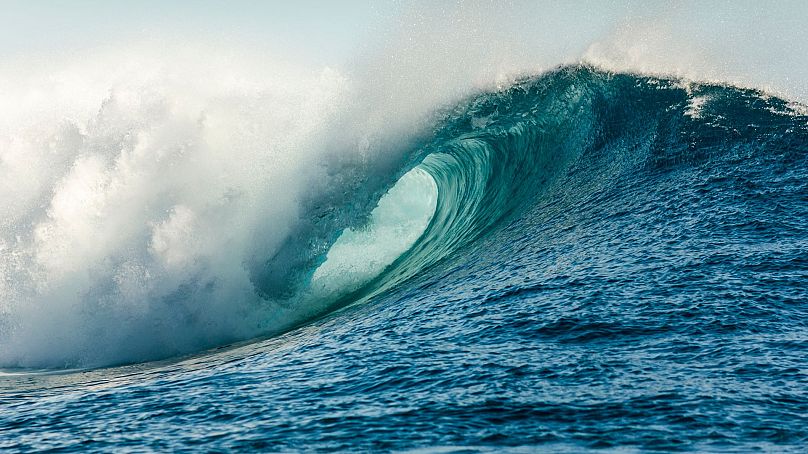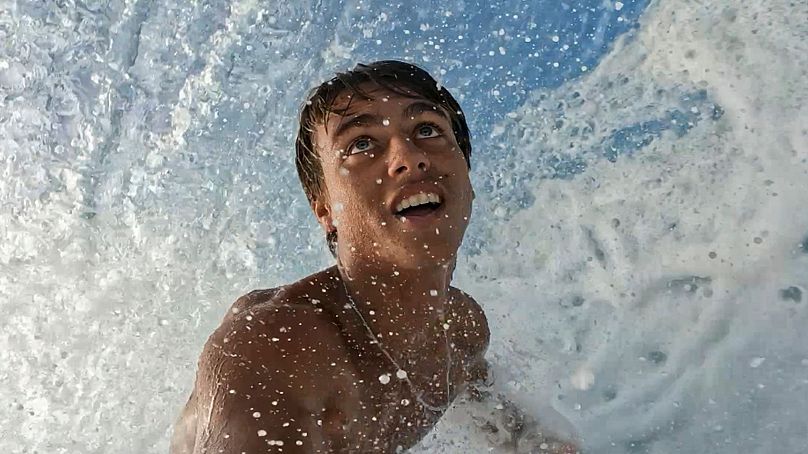Paris 2024 have pushed their sustainability credentials despite the surfing events being held 16,000 km away.
Olympic surfers will have to brave some of the world's biggest waves when they compete in French Polynesia next July.
But the faraway venue has also raised many logistical and environmental questions. The rest of the Summer Games are in the host city, Paris, nearly 16,000 kilometres and 10 time zones away.
Flying 48 surfers, judges, journalists and others so far looks awkward against Paris organisers' stated ambition of reducing the Olympics' carbon footprint by half. Four other surf spots that also bid were dotted along France's Atlantic coast and could easily have been reached by train and bus from the French capital.
Controversial plans for a new aluminium judges' tower have also drawn criticism from environmentalists and local surfers for its potential impact on marine life.
Why is the Olympic surfing being held in Tahiti?
For big-wave enthusiasts, the volcanic island of Tahiti makes sense. The giant swells form in the storm belts of the Southern Ocean, off Antarctica, where whales roam. Supercharged by intense winds, they then roll on an ocean journey of thousands of kilometres to crash into Tahiti in the South Pacific.
The location promises more dramatic television images than when the sport made its Olympic debut at the Tokyo Games in 2021. Then, the waves on Tsurigasaki Beach were sometimes modest, and COVID dented the atmosphere.
Tahiti also has Teahupo'o, a village on the southern shore with lagoons that get the full force of the swells, generating dream surf for the courageous.
"If the conditions are really good, it's going to be a great contest to watch," says surfer Kauli Vaast, an Olympic medal hopeful. The Olympics "are going to be like crazy".
Teahupo'o translates from Tahitian as 'wall of heads'. The name refers to a tribal battle where heads were severed, but it's also appropriate for such fearsome waves. The deep ocean bed rises steeply on final approach to Teahupo'o's offshore reefs, forcing the water into towering walls and huge, rolling tubes.
They are perilous. Surfers who fall risk being body-slammed onto the sharp and shallow corals, which tore chunks off the face of Hawaiian surfer Keala Kennelly when she tumbled in 2011.
Because Teahupo'o's surf breaks offshore, the Olympic judges have to be out in the lagoon, too.
Aluminium viewing tower raises environmental concerns
Organisers intend to house the judges and television cameras on an aluminium tower that will jut out of the ocean. That plan has sparked protests in Tahiti. Its critics fear for coral and other marine life.
Tahitian surfer Matahi Drollet is one of the most vocal opponents. His protest videos on Instagram have racked up hundreds of thousands of views.
A minimal impact viewing tower already exists in Teahupo'o. Built 20 years ago, it has been successfully used for judging and live filming of professional World Surf League (WSL) contests.
But Paris 2024 organisers say that the original tower's foundations do not meet current safety requirements due to natural degradation and corrosion of the structure. A study found that it could not be brought up to standard even if renovation works were carried out.
The option of having judges on the shore or on a boat would not give them sufficient visibility or allow adequate television coverage, Olympic organisers add.
The new €4.6 million aluminium tower would have concrete foundations, and protesters claim large swathes of reef would need to be cleared to make way for drilling. Drollet claims it is being built to provide air conditioning and flushing toilets.
"This new construction is going to destroy a big part of the reef," with disastrous impacts on the marine ecosystem that might only become clear in years to come, he says in a video posted on Instagram. In another video, underwater scenes of a thriving coral reef reportedly show the proposed building site for the tower.
But Paris 2024 organisers have refuted this, sharing a video of the proposed site showing a relatively flat sea bed with coral primarily only on the original foundations. They say the new foundations will be inserted in the intervals of the existing plots to avoid impacting the coral that has developed.
Any coral on the site will be moved outside the work zone according to strict environmental protocols to protect it, they add.
"The protection of the natural environment at Teahupo'o has always been a priority in the conception of all envisaged solutions for the site," Paris 2024 organisers said in a press release last month. "All development plans at Teahupo'o have been studied to minimise impact on the environment."
As well as ensuring safety, the new judges' tower must "guarantee good conditions for the refereeing of the competition, in particular by offering the judges the necessary visibility over the entire wave," they add.
Activists are concerned construction will impact marine life and waves
Drollet says the construction could lead to the spread of ciguatera, a disease that poisons fish and makes them inedible - a particular concern for the fishing town. Previous construction in the fragile marine environments has sparked the disease.
He is even concerned that the tower could modify the waves in the region.
"The impact and the risks are too important for only three days of contest," Drollet says.
"No contest in this world is worth the destruction of nature," he adds in a follow up video. "This goes against the true value of surfing and sports in general."
Titouan Bernicot, founder and CEO of Coral Gardeners - a project that plants coral in French Polynesia - adds, "What will we tell the next generation that for three days of competition we could have destroyed one of the most important ecosystems on our planet?"
They say the plans are at odds with Paris 2024's promise, stated on its website, to "place sustainability at the heart of its project and inspire new standards".
From from January, Paris 2024 organisers are holding monthly public meetings where associations, residents and stakeholders can air their concerns. Representatives of the associations have also been invited to attend each stage of the installation of the tower, starting this month.
They have already settled on a leaner, smaller tower than originally planned, to minimise its environmental impact. This will reduce the depth of drilling for the foundations and allow the use of a barge with a shallower draught during the construction phase.
Olympics could boost tourism in Tahiti
Vaast acknowledges widespread concern about the Olympics' footprint in the Teahupo'o lagoon, saying: "We [are] all scared if they're doing something big."
But he also expects the Olympic spotlight to boost the tourism industry that underpins the Tahitian economy.
"It's going to be great to see a lot of people getting interested in French Polynesia," he says. "And with the construction for the Olympics and stuff, it creates a lot of work for the local people."
21-year-old Vaast hopes the island's legendary surfing conditions are his ticket to a gold medal. He is one of only two French Polynesian surfers qualified so far. The other is Vahine Fierro in the women's competition.
Growing up surrounded by the vast Pacific, Vaast swam, fished and surfed as a kid and was just eight when he first tackled Teahupo'o waves.
He remembers being terrified of their reputation, but he was hooked by their beauty and power. Tahitians say the waves have 'Mana', life-affirming spiritual energy. Vaast believes that his intimate knowledge of Teahupo'o gives him home-field advantage and the "chance of a lifetime" in July.
"I feel this energy nowhere [else] in the world, only in Tahiti, at Teahupo'o," says Vaast, who often travels on the surfing circuit. "When you go there, you need to be respectful because if you respect [it], like the ocean is going to respect you."
For France, the Tahitian venue will allow the host country to highlight its long historical ties to the Pacific and involve its far-off overseas territories in the Summer Games.
Teahupo'o, Tahiti's jewel, is primed to wow.
"When you're in the barrel, you see the mountains" and colours that are "super clear", Vaast says. "You can see the corals underneath... Beautiful. The most beautiful place in the world."













